Note: There is now a newer Novel Coronavirus (2019-nCoV) Situation Report 23.
WHO Novel Coronavirus (2019-nCoV) Situation Report 22
- No new countries reported cases of 2019-nCoV in the past 24 hours.
- An advanced team is currently in Beijing to prepare an international mission and to determine the questions the international team will want to learn more about: from characteristics of the virus to public health response China put in place to try to contain the virus. The group of international experts, with a range of specializations, will work with Chinese counterparts on increasing understanding of the outbreak to guide global response efforts. Since being notified of the outbreak on 31 December, the WHO Country Office in China, supported by the regional and international offices, has worked to support China, and indeed the world, to scale up the response. A small mission was sent to Wuhan mid-January, and the Director-General visited in January.
- Following WHO best practices for naming of new human infectious diseases, which were developed in consultation and collaboration with the World Organisation for Animal Health (OIE) and the Food and Agriculture Organization of the United Nations (FAO), WHO has named the disease COVID-19, short for “coronavirus disease 2019.”
Risk Assessment
China: Very High
Regional Level: High
Global Level: High
Coronavirus Situation in Numbers
Globally
- 43103 confirmed (2560 new)
China
- 42708 confirmed (2484 new)
- 7333 severe (849 new)
- 1017 deaths (108 new)
Outside of China
- 395 confirmed (76 new)
- 24 countries (0 new)
- 1 death (0 new)
TECHNICAL FOCUS: Zoonotic component of 2019-nCoV and human-animal interface
Increasing evidence demonstrates the link between the 2019-nCoV and other similar known coronaviruses (CoV) circulating in bats, and more specifically those of the Rhinolophus bat sub-species. These sub-species are abundant and widely present in Southern China, and across Asia, the Middle East, Africa, and Europe. Recent studies indicate that more than 500 CoVs have been identified in bats in China. To be noted that serological studies conducted in rural population living close to bats natural habitat in caves revealed a 2.9% bat-CoV seroprevalence, demonstrating that human exposure to bat-CoVs might be common.
However, the route of transmission to humans at the start of this event remains unclear. Bats are rare in markets in China but hunted and sold directly to restaurants for food. The current most likely hypothesis is that an intermediary host animal has played a role in the transmission.
Both Chinese and external expert groups are working in trying to identify the animal source of this new virus. Identifying the animal source of the 2019-nCoV would help to ensure that there will be no further future similar outbreaks with the same virus and will also help understanding the initial spread of the disease in the Wuhan area. It would also increase our understanding of the virus and help us understand how these viruses jump from animals to humans. Thus, providing critical knowledge on how to protect us from future similar events. In this regard, strengthening food control and market hygiene activities in live food market will be essential to protect people from similar and other zoonotic diseases.
Countries, territories or areas with reported confirmed cases of 2019-nCoV, February 11, 2020
| Country/Territory/Area | Confirmed Cases |
|---|---|
| China | 42708 |
| International (Cruise Ship in Japan) | 135 |
| Singapore | 45 |
| Thailand | 33 |
| Republic of Korea | 28 |
| Japan | 26 |
| Malaysia | 18 |
| Australia | 15 |
| Germany | 14 |
| Vietnam | 15 |
| United States of America | 13 |
| France | 11 |
| United Arab Emirates | 8 |
| United Kingdom | 8 |
| Canada | 7 |
| India | 3 |
| Italy | 3 |
| Philippines | 3 |
| Russian Federation | 2 |
| Spain | 2 |
| Belgium | 1 |
| Cambodia | 1 |
| Finland | 1 |
| Nepal | 1 |
| Sri Lanka | 1 |
| Sweden | 1 |
| Total | 43103 |
Recommendations and Advice for the Public
During previous outbreaks due to other coronaviruses (Middle-East Respiratory Syndrome (MERS) and Severe Acute Respiratory Syndrome (SARS), human-to-human transmission occurred through droplets, contact, and fomites, suggesting that the transmission mode of the 2019-nCoV can be similar. The basic principles to reduce the general risk of transmission of acute respiratory infections include the following:
- Avoiding close contact with people suffering from acute respiratory infections.
- Frequent hand-washing, especially after direct contact with ill people or their environment.
- Avoiding unprotected contact with farm or wild animals.
- People with symptoms of acute respiratory infection should practice cough etiquette (maintain distance, cover coughs and sneezes with disposable tissues or clothing, and wash hands).
- Within healthcare facilities, enhance standard infection prevention and control practices in hospitals, especially in emergency departments.
WHO does not recommend any specific health measures for travelers. In case of symptoms suggestive of respiratory illness either during or after travel, travelers are encouraged to seek medical attention and share their travel history with their healthcare provider.

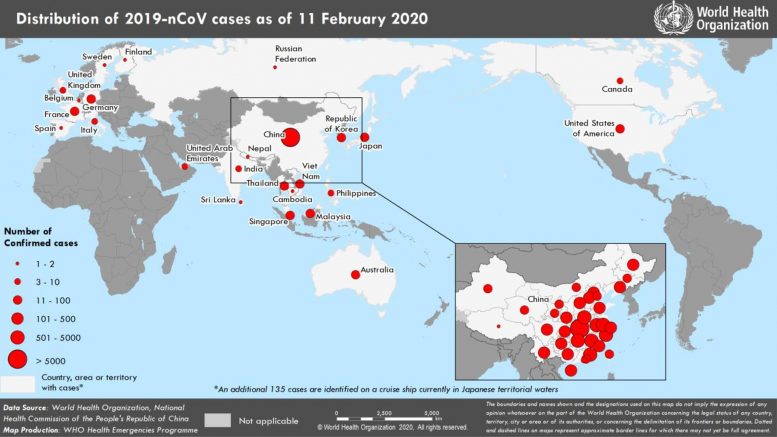
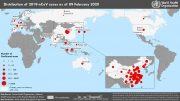
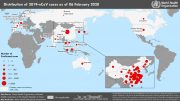
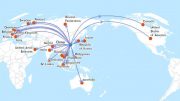
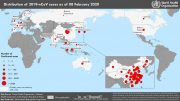
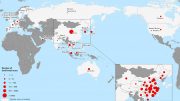
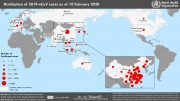
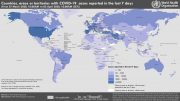
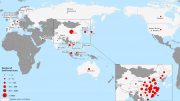
Be the first to comment on "Coronavirus Outbreak Death Toll Tops 1,000 With 43,103 Confirmed Cases Worldwide"